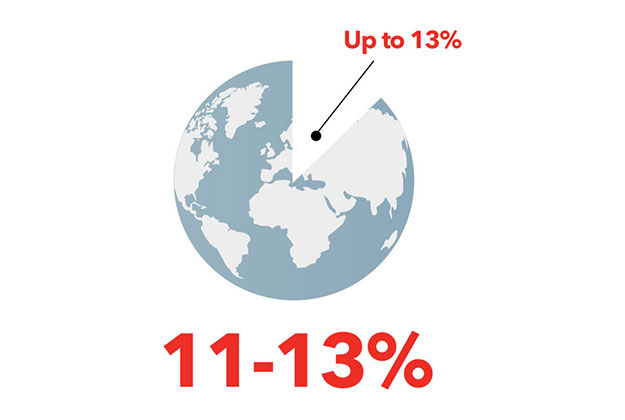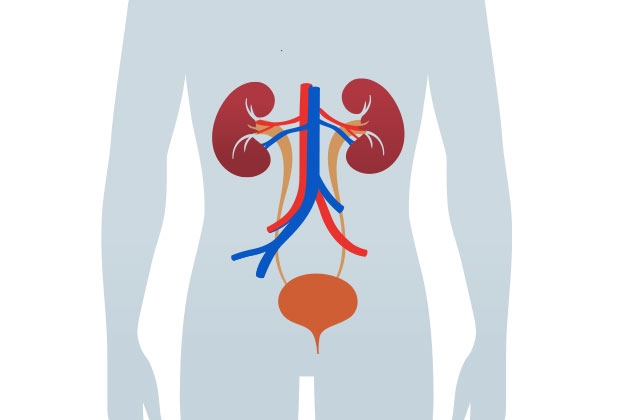CKD is a global health issue1
Chronic kidney disease (CKD) affects up to 13% of the global population.1 Being diagnosed with kidney disease can be a huge challenge, both for the patient and those people around them. Its diagnosis and management, particularly in advanced stages of kidney disease, can impact severely upon their physical and mental state.4

Global prevalence of CKD by stage
As shown in the graph, the estimated global CKD prevalence is between 11 and 13% with the majority of patients in stage 3.1 These results are in accordance with a more recent study by Obrador published in 2019.5

Understanding CKD - Kidney basics

You have two kidneys, each about the size of an adult fist, located on either side of the spine just below the rib cage. Although they are small, your kidneys perform many complex and vital functions that keep the rest of the body in balance, including elimination of wastes, regulation of blood composition, blood volume and blood pressure, as well as mineral homeostasis. When the kidneys are damaged or diseased, they can abruptly or progressively lose their ability to perform these vital functions. This results in waste and fluid build-up and abnormal hormonal regulation of blood pressure and mineral homeostasis.
The kidneys regulate:2

Waste elimination

Blood composition

Blood volume

Blood pressure

Mineral homeostasis
Definition of chronic kidney disease3
Chronic kidney disease describes the gradual loss of kidney function. According to the KDIGO 2017 Clinical Practice Guideline, CKD is defined as abnormalities of kidney structure or function, present for more than 3 months, with implications for health. Chronic kidney disease includes conditions that damage your kidneys and decrease their ability to keep you healthy. If kidney disease gets worse, wastes can build to high levels in your blood and make you feel sick. You may develop complications like high blood pressure, anemia (low blood count), weak bones, poor nutritional health and nerve damage. Also, kidney disease increases your risk of having heart and blood vessel disease.
Stages of CKD
based on glomerular filtration rate (GFR)3
The KDIGO 2017 Clinical Practice Guideline suggests the classification of chronic kidney disease into five stages, based on glomerular filtration rate (or GFR), which is one of the measures of kidney function that describes the flow rate of filtered fluid through the kidney. This measure tells you how much kidney function you have. As kidney disease gets worse, the GFR number goes down.

Talk to your doctor
If you have been diagnosed with CKD it is likely that you will have regular follow up appointments with your doctor to check how you are feeling and to monitor the progress of your symptoms. If you have been feeling fatigued or think you may have any of the symptoms of iron deficiency such as paleness, faintness or a racing heart, you may want to speak to your doctor about your symptoms. To get the most out of your visit, think in advance about the information that the doctor might need in order to work out what is causing your symptoms. You should also prepare any questions that you want to ask.
HQ-NA-2100201. Date of preparation September 2021
- Hill NR, et al. PLoS One. 2016;11(7):e0158765
- https://www.kidney.org/kidneydisease/howkidneyswrk date of access August 2020
- Levey AS, et al. Kidney Int. 2005;67(6):2089-2100
- Kefale B, Alebachew M, Tadesse Y, Engidawork E (2019) Quality of life and its predictors among patients with chronic kidney disease: A hospital-based cross sectional study.PLoS ONE 14(2): e0212184.
- Obrador GT. Epidemiology of chronic kidney disease. UpToDate. 2019
Si padece EII de cualquier tipo, corre el riesgo de sufrir anemia / déficit de hierro. Aproximadamente del 36 % al 76 % de las personas con EII padecen anemia ferropénica (anemia por déficit de hierro). Obtenga más información sobre el riesgo de la ADH.
Los síntomas de la anemia / déficit de hierro pueden afectar a muchas áreas de su organismo. Puede experimentar uno o más de estos síntomas al mismo tiempo. Explore todos los signos del déficit de hierro.
Si le han diagnosticado EII, es probable que tenga citas de seguimiento periódicas con su médico. Si se ha sentido fatigado o tiene otros signos de anemia / déficit de hierro como palidez, debilidad o palpitaciones, es posible que desee hablar con su médico sobre sus síntomas y la anemia / déficit de hierro. Es útil pensar en la información que el médico podría necesitar para determinar qué está provocando sus síntomas. El médico puede realizar un análisis de sangre para verificar su nivel de hierro antes de pautar un tratamiento para mejorar sus niveles de hierro.
Opciones de tratamiento
Una vez que su médico haya analizado sus niveles de hierro, podrá decidir el tratamiento más conveniente para usted. Este dependerá de la severidad de anemia / déficit de hierro que presente y podría aconsejarle sobre cómo obtener más hierro de su dieta y/o recomendarle ciertos medicamentos para mejorar sus niveles de hierro. Puede encontrar más información sobre las diferentes opciones de tratamiento y cómo obtener la mayor cantidad de hierro de su dieta siguiendo el enlace.
Si padece EII de cualquier tipo, corre el riesgo de sufrir anemia / déficit de hierro. Aproximadamente del 36 % al 76 % de las personas con EII padecen anemia ferropénica (anemia por déficit de hierro). Obtenga más información sobre el riesgo de la ADH.
Los síntomas de la anemia / déficit de hierro pueden afectar a muchas áreas de su organismo. Puede experimentar uno o más de estos síntomas al mismo tiempo. Explore todos los signos del déficit de hierro.
Si le han diagnosticado EII, es probable que tenga citas de seguimiento periódicas con su médico. Si se ha sentido fatigado o tiene otros signos de anemia / déficit de hierro como palidez, debilidad o palpitaciones, es posible que desee hablar con su médico sobre sus síntomas y la anemia / déficit de hierro. Es útil pensar en la información que el médico podría necesitar para determinar qué está provocando sus síntomas. El médico puede realizar un análisis de sangre para verificar su nivel de hierro antes de pautar un tratamiento para mejorar sus niveles de hierro.
Opciones de tratamiento
Una vez que su médico haya analizado sus niveles de hierro, podrá decidir el tratamiento más conveniente para usted. Este dependerá de la severidad de anemia / déficit de hierro que presente y podría aconsejarle sobre cómo obtener más hierro de su dieta y/o recomendarle ciertos medicamentos para mejorar sus niveles de hierro. Puede encontrar más información sobre las diferentes opciones de tratamiento y cómo obtener la mayor cantidad de hierro de su dieta siguiendo el enlace.




